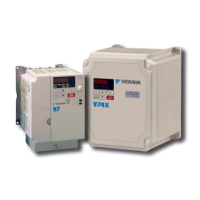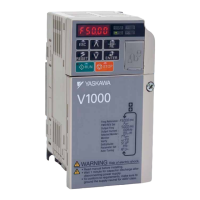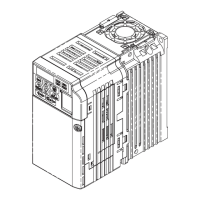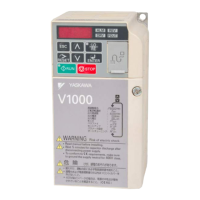n
Noise From Drive or Output Lines When the Drive is Powered On
Cause Possible Solutions
Relay switching in the drive
generates excessive noise.
• Lower the carrier frequency (C6-02).
• Install a noise filter on the input side of drive input power.
• Install a noise filter on the output side of the drive.
• Place the wiring inside a metal conduit to shield it from switching noise.
• Ground the drive and motor properly.
• Separate the main circuit wiring and the control lines.
n
Ground Fault Circuit Interrupter (GFCI) Trips During Run
Cause Possible Solutions
Excessive leakage current trips
MCCB.
• Increase the GFCI sensitivity or use GFCI with a higher threshold.
• Lower the carrier frequency (C6-02).
• Reduce the length of the cable used between the drive and the motor.
• Install a noise filter or reactor on the output side of the drive.
n
Connected Machinery Vibrates When Motor Rotates
Excessive Motor Oscillation and Erratic Rotation
Cause Possible Solution
Poor balance between motor phases. Check drive input power voltage to ensure that it provides stable power.
Unexpected Noise from Connected Machinery
Cause Possible Solutions
The carrier frequency is at the resonant frequency of
the connected machinery.
Adjust the carrier frequency using parameters C6-02 through C6-05.
The drive output frequency is the same as the
resonant frequency of the connected machinery.
• Adjust the parameters used for the Jump Frequency function (d3-01 through d3-04) to skip
the problem-causing bandwidth.
• Place the motor on a rubber pad to reduce vibration.
Note: The drive may have trouble assessing the status of the load due to white noise generated when using Swing PWM (C6-02 = 7 to A).
n
Oscillation or Hunting
Cause Possible Solutions
Insufficient tuning in Open Loop Vector Control
Adjust the following parameters in the order listed.
An increase in gain should be followed with an increase in the primary delay time constant.
• C4-02 (Torque Compensation Primary Delay Time)
• n2-01 (Speed Feedback Detection Control [AFR] Time Constant 1)
• C3-02 (Slip Compensation Primary Delay Time)
The response for torque compensation and slip compensation will drop as the time constant
is increased.
Auto-Tuning has not yet been performed (required
for Open Loop Vector Control).
Perform Auto-Tuning.
Set motor parameters after calculating the proper values.
Change the motor control method to V/f Control (A1-02 = “0”).
Insufficient tuning in V/f Control.
Reduce the gain.
• n1-02 (Hunting Prevention Gain Setting)
• n1-03 (Hunting Prevention Time Constant Setting)
Gain is too low when using PID control. Check the period of oscillation and adjust P, I, and D settings accordingly.
The frequency reference is assigned to an external
source and the signal is noisy.
• Ensure that noise is not affecting the signal lines.
• Separate main circuit wiring and control circuit wiring.
• Use twisted-pair cables or shielded wiring for the control circuit.
• Increase the analog input time filter constant (H3-13).
The cable between the drive and motor is too long.
• Perform Auto-Tuning.
• Reduce the length of the cable.
6.9 Troubleshooting without Fault Display
YASKAWA ELECTRIC SIEP C710606 16C YASKAWA AC Drive – V1000 Technical Manual
285
6
Troubleshooting
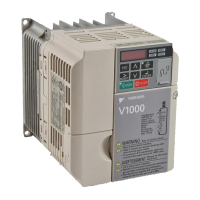
